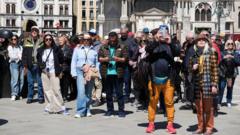In a bid to address the overwhelming influx of tourists, Venice has announced that it will double the number of days when an entry fee will be charged for visitors beginning in 2025. Mayor Luigi Brugnaro stated that the city aims to promote respect for its cultural heritage and discourage large groups from visiting on the same days.
Venice to Extend Tourist Entry Fee Days to Combat Overtourism

Venice to Extend Tourist Entry Fee Days to Combat Overtourism
Starting in 2025, Venice will implement a longer entry fee period for tourists to tackle overcrowding and protect its historical sites, as highlighted by the city's mayor.
The fee structure will see tourists who plan ahead paying €5 (£4.17; $5.41) to enter Venice on designated days from April to July, while those who book less than four days in advance will pay €10. This change follows a "successful" pilot program last year that charged tourists on specific weekends and holidays for 29 days over four months, raising around €2.4 million in fees by the end of the trial period.
The city plans to apply this fee every Friday through Sunday and on public holidays, increasing the total number of chargeable days to 54 during the specified timeframe. All visitors aged 14 and above will need to pay the entrance fee via their phones and display a QR code for random inspections at various entry points, such as the train station. Exemptions will apply to hotel patrons, residents of the Veneto region, Venice university students, and those visiting family members in the city.
Venice has been criticized for being a prime example of overtourism and is reportedly among the first cities globally to take proactive measures against it. Despite the revenue generated from the scheme, the mayor indicated further analysis is needed to assess its financial viability, especially considering the setup and advertising costs amounting to about €3 million.
Opposition figures, such as councilor Giovanni Andrea Martini, have criticized the fee's effectiveness, asserting it failed to adequately manage tourist traffic and contained a "museum-like" concept that could harm the city's dynamics. As the city grapples with climate change impacts and heavy tourism, which have led to UNESCO flagging it as a "world heritage site in danger," these measures reflect an urgent call for sustainable tourism practices.
In addition, past restrictions such as the 2021 ban on large cruise ships from the city center highlight ongoing debates about the balance between tourism and preservation. With Venice’s unique landscape and cultural identity at stake, the local government hopes to set a precedent in sustainable tourism management that could inspire other tourist-heavy locales around the world.
The city plans to apply this fee every Friday through Sunday and on public holidays, increasing the total number of chargeable days to 54 during the specified timeframe. All visitors aged 14 and above will need to pay the entrance fee via their phones and display a QR code for random inspections at various entry points, such as the train station. Exemptions will apply to hotel patrons, residents of the Veneto region, Venice university students, and those visiting family members in the city.
Venice has been criticized for being a prime example of overtourism and is reportedly among the first cities globally to take proactive measures against it. Despite the revenue generated from the scheme, the mayor indicated further analysis is needed to assess its financial viability, especially considering the setup and advertising costs amounting to about €3 million.
Opposition figures, such as councilor Giovanni Andrea Martini, have criticized the fee's effectiveness, asserting it failed to adequately manage tourist traffic and contained a "museum-like" concept that could harm the city's dynamics. As the city grapples with climate change impacts and heavy tourism, which have led to UNESCO flagging it as a "world heritage site in danger," these measures reflect an urgent call for sustainable tourism practices.
In addition, past restrictions such as the 2021 ban on large cruise ships from the city center highlight ongoing debates about the balance between tourism and preservation. With Venice’s unique landscape and cultural identity at stake, the local government hopes to set a precedent in sustainable tourism management that could inspire other tourist-heavy locales around the world.



















